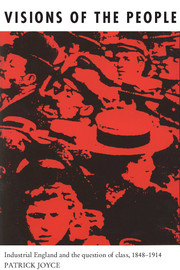Book contents
- Frontmatter
- Contents
- List of plates
- Acknowledgements
- 1 Introduction: beyond class?
- PART I POWER AND THE PEOPLE: POLITICS AND THE SOCIAL ORDER
- 2 The languages of popular politics: from radicalism to Liberalism
- 3 Class, populism and socialism: Liberalism and after
- PART II MORALISING THE MARKET: WORK AND THE SOCIAL ORDER
- PART III CUSTOM, HISTORY, LANGUAGE: POPULAR CULTURE AND THE SOCIAL ORDER
- PART IV KINGDOMS OF THE MIND: THE IMAGINARY CONSTITUTION OF THE SOCIAL ORDER
- Appendices
- Bibliographical note
- Notes
- Index
3 - Class, populism and socialism: Liberalism and after
Published online by Cambridge University Press: 05 March 2012
- Frontmatter
- Contents
- List of plates
- Acknowledgements
- 1 Introduction: beyond class?
- PART I POWER AND THE PEOPLE: POLITICS AND THE SOCIAL ORDER
- 2 The languages of popular politics: from radicalism to Liberalism
- 3 Class, populism and socialism: Liberalism and after
- PART II MORALISING THE MARKET: WORK AND THE SOCIAL ORDER
- PART III CUSTOM, HISTORY, LANGUAGE: POPULAR CULTURE AND THE SOCIAL ORDER
- PART IV KINGDOMS OF THE MIND: THE IMAGINARY CONSTITUTION OF THE SOCIAL ORDER
- Appendices
- Bibliographical note
- Notes
- Index
Summary
Managing class
By the 1870s Gladstone had made the crusade of the ‘masses’ against the ‘classes’ a central part of national politics. However, Bright's flattery of the ‘working classes’ (the plural was usually used) involved a concentration upon the collective attributes attached to a class, and contemporaries and politicians of all sorts were fond of dwelling upon the ‘energy’ of the middle classes, the idleness of the aristocracy, or the morality and ‘industry’ of the workers. The familiar tripartite division was much used, and this indicates the extent to which class distinctions were recognised as real in British society. But it is how these were used, and how much they counted that matters. Here, popular Liberalism, the creed of so many of the ‘working classes’ of the time, provides us with our best guide. It seems that the positive attributes of class were accepted, in so far as they contributed to the realisation of broader and more inclusive social and political identities. The ‘negative’ and divisive aspects of class were anathematised, by all classes. Popular Liberalism, and in fact popular Toryism as well, were about the union of the classes against class.
- Type
- Chapter
- Information
- Visions of the PeopleIndustrial England and the Question of Class, c.1848–1914, pp. 56 - 84Publisher: Cambridge University PressPrint publication year: 1991
- 1
- Cited by



